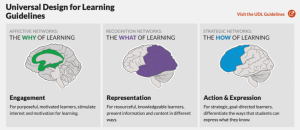
Many within the ATE Community are knowledgeable about the importance of creating accessible classroom documents, but even the most experienced among us can benefit from a few practical tips. Those in search of guidance on developing Universal Design for Learning (UDL)-aligned materials may benefit from the resources assembled by the NSF-funded AccessATE project and the National AEM Center at CAST, an AccessATE project partner.
The goal in making educational content accessible is to make information attainable for the widest range of learners possible. It’s easy to assume that the way to make content accessible is to change the format of the material; however that approach is often the least effective method. A good analogy is to consider a building entrance. If the entrance is designed from the start to be usable by everyone who comes and goes from the building, people with different needs and modalities share an equal experience – they are all using the front entrance together. However, if accessibility is an afterthought, then often the chosen solution is to create a separate accessible entrance – for example, placing a ramp at the alley door of a building because the front door has stairs. While this may be the only practical approach in some situations, it ends up sending the message that individuals needing ramp access are of lower priority. When applied to educational resources, building accessibility into materials from the beginning is where UDL comes into play.
UDL helps verify that accessibility is not an afterthought, incorporating a full understanding of diverse student requirements into the creation of course tools. The UDL guidelines focus on engagement (the why of learning), representation (the what of learning), and action and expression (the how of learning) to guarantee that educational materials are authored with a diverse set of students in mind. Classroom documents that are UDL-aligned provide multiple means of engagement, representation, and action and expression. This ensures that students with different strengths and needs will find a means of each that works for them.
A great place to start in verifying that your educational materials meet accessibility standards is watching the recent Designing Accessibility with POUR webinar presented by Luis Pérez, TA Specialist for the National AEM Center at CAST and Rachael Bower, PI of AccessATE and ATE Central. The talk covers how accessibility guidelines can be “distilled into four core principles, as captured by the acronym POUR (Perceivable, Operable, Understandable and Robust), that define four qualities of an accessible user experience.” Then, with the revision of a course syllabus as context, the webinar offers practical, applied techniques educators can implement right away. Instructors can build upon their higher-level understanding of the POUR core qualities to ensure their classroom materials “are accessible and work for all learners from the start, by design.”
Some easy suggestions for crafting UDL learning tools that the POUR approach offers include:
- Add effective alternative text to images to make the information perceivable to a wider audience.
- Factor in interaction and response time when developing classroom tools for peak operability.
- Avoid language that may exclude certain learners to ensure content is understandable.
- Perform an accessibility check on all educational materials for robust accessibility.
For more insight into making your classroom documents accessible, view the webinar slides or watch the recording.

 Subscribe
Subscribe


 See More ATE Impacts
See More ATE Impacts

Comments
There are no comments yet for this entry. Please Log In to post one.